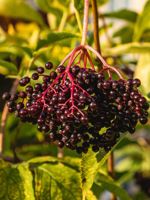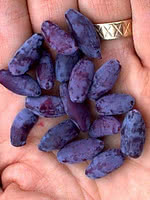Mon-Fri 9am - 5pm Mountain time
Berry Blue Haskap (Honeyberry) vs Bob Gordon Elderberry
Sambucus canadensis Bob Gordon
Lonicera caerulea Berry Blue
NOT AVAILABLE THIS SEASON - MIGHT RETURN
Bob Gordon Elderberry is a Black Elderberry cultivar that produces berries that are larger and sweeter than other varieties, making it one of the top cultivars. It produces large clusters of white flowers that turn into large clusters of dark purple to black berries. The berries are well-suited for baked goods, jams, jellies, and syrups. It was selected from the wild in Missouri.
The large berry clusters that the Bob Gordon Elderberry produces will often end up hanging downward. This makes it more difficult for birds to feed on the berries. If birds are a concern, this might be the right berry for you.
Black Elderberries are considered to be partially self-pollinating. So while they will still produce some berries without cross-pollination, planting with another variety will increase yields. Consider planting with Black Elderberry or Ranch Elderberry.
Warning: the seeds, stems, leaves, roots, and uncooked berries are toxic to humans when eaten in quantity. Berries should be cooked to make them safe for human consumption.
Berry Blue Honeyberry is a hardy deciduous shrub. Its fruit is deliciously tart and perfect for fresh eating or production.
Berry Blue is an early pollinating variety. Pair with other early pollinators to have a higher yield.
Aurora is a great companion variety.
Haskap is the Japanese name for these berries and this term has been adopted for the University of Saskatchewan varieties. In other areas they are more commonly known as Honeyberry which is why we call this Eastern European variety Honeyberry.
Bob Gordon Elderberry Quick Facts
Berry Blue Haskap (Honeyberry) Quick Facts
Toxicity: leaves, stems, and uncooked berries are poisonous to humans

